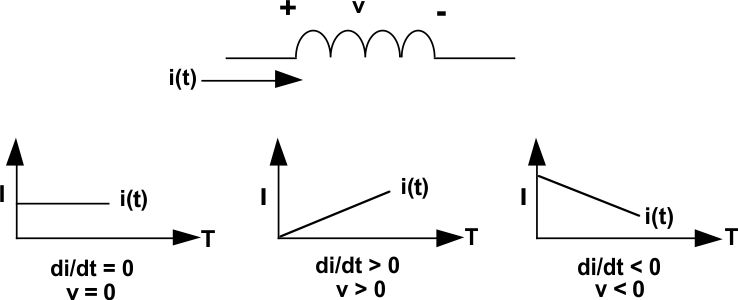SNVA559C September 2012 – February 2019 LM2574 , LM2575-N , LM2575HV , LM2576 , LM2576HV , LM2577
-
Switching regulator fundamentals
- Trademarks
- 1 Switching Fundamentals
- 2 Switching Converter Topologies
- 3 Application Hints for Switching Regulators
- 4 Application Circuits
- 5 References and Related Products
- Revision History
1.1 The Law of Inductance
If a voltage is forced across an inductor, a current will flow through that inductor (and this current will vary with time).
NOTE
The current flowing in an inductor will be time-varying even if the forcing voltage is constant.
It is equally correct to say that if a time-varying current is forced to flow in an inductor, a voltage across the inductor will result.
The fundamental law that defines the relationship between the voltage and current in an inductor is given by Equation 1:
Two important characteristics of an inductor that follow directly from the law of inductance are:
- A voltage across an inductor results only from a current that changes with time. A steady (DC) current flowing in an inductor causes no voltage across it (except for the tiny voltage drop across the copper used in the windings).
- A current flowing in an inductor can not change value instantly (in zero time), as this would require infinite voltage to force it to happen. However, the faster the current is changed in an inductor, the larger the resulting voltage will be.
NOTE
Unlike the current flowing in the inductor, the voltage across it can change instantly (in zero time).
The principles of inductance are illustrated by the information contained in Figure 1.
 Figure 1. Inductor Voltage/Current Relationship
Figure 1. Inductor Voltage/Current Relationship The important parameter is the di/dt term, which is simply a measure of how the current changes with time. When the current is plotted versus time, the value of di/dt is defined as the slope of the current plot at any given point.
The graph on the left shows that current which is constant with time has a di/dt value of zero, and results in no voltage across the inductor.
The center graph shows that a current which is increasing with time has a positive di/dt value, resulting in a positive inductor voltage.
Current that decreases with time (shown in the right-hand graph) gives a negative value for di/dt and inductor voltage.
It is important to note that a linear current ramp in an inductor (either up or down) occurs only when it has a constant voltage across it.